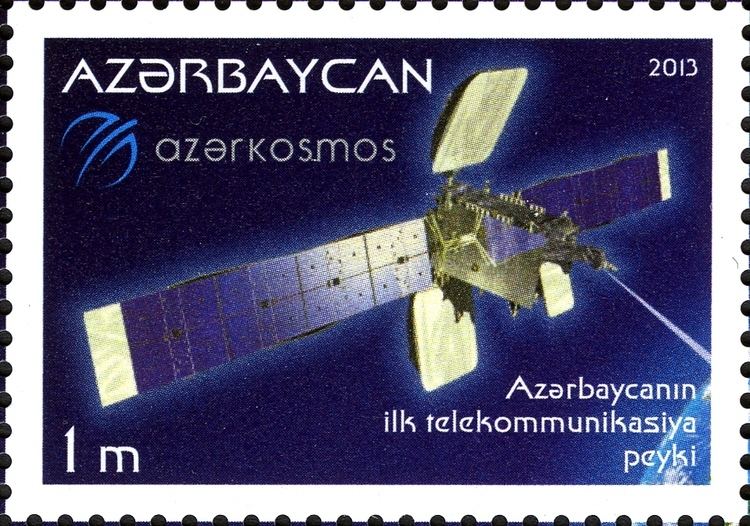Mission type Communications COSPAR ID 2013-006B Mission duration 15 years | Operator Azercosmos
MEASAT SATCAT no. 39079 Bus GEOStar-2 | |
 | ||
Azerspace-1/Africasat-1a, also known as AzerSat-1 (Azerbaijani: AzərSat-1) is Azerbaijan's first satellite in space. Built by Orbital Sciences Corporation, it was launched into orbit on February 7, 2013 from Kourou in French Guiana at orbital positions 46° east. The satellite was launched aboard Ariane 5. The satellite covers Europe and a significant part of Asia and Africa. It has transmission capabilities for TV, radio broadcasting and the internet.
Contents
The satellite has an anticipated service life of 15 years.
Cost
It is believed that the satellite cost of US$ 120 million and was established by Orbital Sciences Corporation. Arianespace’s president Jean-Yves Le Gall emphasized that the weight of the satellite would be three tonnes. In April 2011, Export-Import Bank of the United States has approved financing of this project as 85 percent of construction cost which will be provided to the Azerbaijani side in the form of a loan, while the remaining 15 percent will be paid by state funds. The funds will be issued to Azerkosmos OJSC.
Satellite specifications
The satellite has solar arrays with four panels per array, using UTJ Gallium Arsenide cells. It will be stabilized with a 3-axis stabilized, zero momentum system. It will have a liquid bi-propellant transfer orbit system, with a monopropellant (hydrazine) on-orbit system. Power will be held in two Li-Ion batteries with a capacity of >4840 W/hr.
Azersat/Africasat-1A will have a hybrid payload including both C- band and Ku-band antennae. There will be 24 active C-band transponders, using a 2.5 m × 2.7 m (8 ft 2 in × 8 ft 10 in) single shell super-elliptical deployable reflector, with a 1.4 m × 1.4 m (4 ft 7 in × 4 ft 7 in) single shell super-elliptical deck-mounted reflector. There will also be 12 active Ku-band transponders, using a 2.5 m × 2.7 m (8 ft 2 in × 8 ft 10 in) single shell super-elliptical deployable reflector.
The Ku-band transponders (11.2 GHz and 14.0 GHz) have a contour map that primarily covers Europe and Central Asia. The C-band contour map (3740 MHz and 5965 MHz) also covers Europe and Central Asia, as well as nearly all of Africa.
Orbit
The satellite based on Orbital’s flight-proven STAR-2 platform and generates approximately five kilowatts of payload power for 36 active transponders. Upon completion of in-orbit testing, operational control of the satellite was handed over to Azerbaijan’s Ministry of Communications and IT.
Operation
The satellite's operations are controlled by a state-run company, Azercosmos, operating under the Azerbaijan’s Ministry of Communications and IT. Azersat/Africasat-1A is a joint venture between Azerbaijan and satellite fleet operator MEASAT Satellite Systems of Malaysia, which owns the rights to the orbital slot at 46 degrees east longitude, and which will be using about 40 percent of the satellite’s total capacity. Azerbaijan uses 20 percent, with the remaining capacity to be available for other customers.
As of 2014, satellite carries 13 radio stations and 128 television channels, mostly free to air, in addition to its services to the government.
Launch
The Azersat/Africasat-1A has had a planned launch for mid-2012 by Europe’s Arianespace launch consortium under a separate contract valued at $93 million. Azerbaijan and its bank consortium, led by BNP Paribas, has reportedly been negotiating with France’s Coface export-credit agency to back the launch-services contract. On 23 November 2011, it was confirmed the launch would proceed within the expected 2012 timetable.
Future plans
The launch of its own satellite on orbit became Azerbaijan's first action in realizing prospective projects to turn itself into a country with a space industry. In addition, deputy director of Azerbaijan National Aerospace Agency, Tofig Suleymanov in April 2011 hinted that Azerbaijan may launch second artificial satellite to study the Earth's interior and atmosphere in 2014. On 26 November 2011, Head of Azercosmos, Rashad Nabiyev has reported that launch of the second satellite expected to start in 2015.
